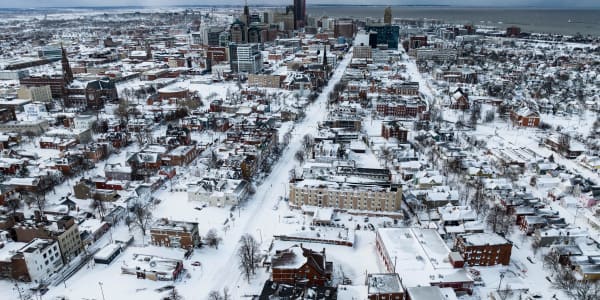America is in the midst of an infrastructure renaissance.
Powered by the $1.2 trillion Infrastructure Investment and Jobs Act — otherwise known as the bipartisan infrastructure law — states are rebuilding their roads and bridges, refurbishing ports and airports, and upgrading their electric, water and broadband utilities.
The work is long overdue, and it is badly needed. Not only is infrastructure essential to our daily lives, it is also a key to economic competitiveness. That is why it plays such an important role in CNBC's annual America's Top States for Business rankings.
Infrastructure is the second most important category — after Workforce — under this year's methodology. We consider roads, bridges, railroads, ports, airports and utilities. We gauge the reliability of the power grid and broadband connectivity. We rate the states on sustainability — where is the most renewable energy, and which states are most at risk of floods, wildfires, and extreme weather? We consider which states have the most space available for development, and which have the most population within a day's drive.
Some states need the new federal help much more than others — America's Worst States for Infrastructure. But these states are already leading the way, with America's best infrastructure.
10. (tie) Virginia
Virginia is a leader in access — both real and virtual. With more than 120 million people within a day's drive, the Old Dominion's location is nearly ideal. Internet connectivity is also excellent, with ready access and high speeds, according to Broadband Now Research, and the state will receive another $100 million for broadband under the infrastructure law. The commercial real estate market in Virginia suffered during the pandemic and has yet to rebound. But that means there are plenty of prime locations for development.
2023 Infrastructure score: 231 out of 390 points (Top States grade: B)
U.S. population within 500 miles: 120,826,520
Bridges in poor condition: 4%
Roads in unacceptable condition: 13%
Broadband access: 91.2%
Power outages per year: 7.2 hours
10. (tie) Kansas
Being in the geographic center of the nation would mean a lot less were it not for the fact that Kansas has impeccable roads and bridges. Ninety-five percent are in good condition, according to U.S. Department of Transportation data, which means you will enjoy a breezy 19.6-minute average commute to work. Kansas also scores well for sustainability, with low risk of floods. The state gets 47% of its energy from renewable sources. The new infrastructure law allocates nearly $58 million for energy projects in Kansas over the next two years.
2023 Infrastructure score: 231 out of 390 points (Top States grade: B)
U.S. population within 500 miles: 43,062,013
Bridges in poor condition: 5%
Roads in unacceptable condition: 5%
Broadband access: 87.1%
Power outages per year: 5.7 hours
10. (tie) Colorado
Denver International Airport, the third-busiest in the world based on passengers, generates more than $33 billion a year in economic benefits to the Centennial State. The airport set an all-time record for passenger traffic last year, putting it back above pre-pandemic levels. To build on that success, Colorado has already received $315 million for airports under the infrastructure law.
2023 Infrastructure score: 231 out of 390 points (Top States grade: B)
U.S. population within 500 miles: 17,399,420
Bridges in poor condition: 5%
Roads in unacceptable condition: 16%
Broadband access: 91%
Power outages per year: 3 hours
9. Nevada
Despite climate extremes including heat, drought, wildfires and mountain snow, Nevada's power grid is among the nation's most reliable, according to U.S. Department of Energy data. The average customer is without power for just 102 minutes per year. The state's largest electric utility, NV Energy, recently won approval for a $333 million natural gas power plant near Las Vegas to address growing demands. But environmental groups criticized the project, in a state that gets just one-third of its power from renewables. The infrastructure law has thus far allocated more than $155 million for energy projects in Nevada.
2023 Infrastructure score: 235 out of 390 points (Top States grade: B+)
U.S. population within 500 miles: 51,904,491
Bridges in poor condition: 1%
Roads in unacceptable condition: 5%
Broadband access: 92.1%
Power outages per year: 1.7 hours
8. South Carolina
The Palmetto State is a leader in internet connectivity. South Carolina's broadband office, created in 2021, recently announced a partnership with Clemson University to improve access in rural parts of the state. Researchers are constantly measuring and mapping connectivity statewide, to ensure that no South Carolinian is unconnected. The state has already received $5 million for broadband under the bipartisan infrastructure law, and it is in line to ultimately receive at least $100 million.
2023 Infrastructure score: 240 out of 390 points (Top States grade: B+)
U.S. population within 500 miles: 90,868,564
Bridges in poor condition: 5%
Roads in unacceptable condition: 11%
Broadband access: 91.6%
Power outages per year: 2 hours
7. Arizona
Arizona is emerging as one of the biggest winners in the U.S. crusade to revitalize the domestic semiconductor industry, with Taiwan Semiconductor Manufacturing Company's $40 billion investment in the state. The Grand Canyon State's infrastructure is a big reason why. For one thing, Arizona has plenty of space available for development, according to data from commercial real estate firm CoStar Group. The state also boasts the second-most reliable power grid (behind Alabama), with the average customer losing power for only about an hour per year. The state has received nearly $82 million for clean energy and power projects thus far under the infrastructure law.
2023 Infrastructure score: 241 out of 390 points (Top States grade: B+)
U.S. population within 500 miles: 42,351,524
Bridges in poor condition: 1%
Roads in unacceptable condition: 13%
Broadband access: 88%
Power outages per year: 1 hour
6. Ohio
No state is more strategically located than Ohio — more than 139 million people live within a day's drive. Whether by road, rail, water or air, the Buckeye State is a leader in the value of goods shipped, at more than $34 billion per year, according to the most recent Census data. Ohio has plenty of sites available for development. And with relatively limited risk of extreme weather, the state is less susceptible than most to climate change. But the state gets relatively little of its power from renewables, and its aging water systems face a growing repair bill — more than $16 billion over the next 20 years, according to the Environmental Protection Agency. The infrastructure law includes $651 million to address Ohio's water needs in the first two years.
2023 Infrastructure score: 245 out of 390 points (Top States grade: A-)
U.S. population within 500 miles: 139,114,704
Bridges in poor condition: 5%
Roads in unacceptable condition: 15%
Broadband access: 94.3%
Power outages per year: 4 hours
5. Indiana
The Hoosier State is one of the nation's leading states for rail. Nearly 300 million tons of freight traveled on Indiana rail lines in 2021, according to the most recent U.S. Department of Transportation figures available. While the state is not quite as strategically located as neighboring Ohio, it still lives up to its other nickname — the Crossroads of America. Indiana is also home to key ports on Lake Michigan and the Ohio River. The bipartisan infrastructure law has sent $8 million for ports and waterways to Indiana thus far.
2023 Infrastructure score: 253 out of 390 points (Top States grade: A-)
U.S. population within 500 miles: 111,201,365
Bridges in poor condition: 5%
Roads in unacceptable condition: 6%
Broadband access: 88.8%
Power outages per year: 4.8 hours
3. (tie) Tennessee
Though recent years have brought devastating headlines about flooding and tornadoes, on a relative basis, there is less risk of extreme weather in the Volunteer State. Tennessee is another state that sits in a sweet spot location-wise, with ready access to population centers in the South, Midwest, and Mid-Atlantic. The state's power grid is not as reliable as it should be, but help is on the way in the form of $393 million for power and clean energy under the infrastructure law.
2023 Infrastructure score: 254 out of 390 points (Top States grade: A-)
U.S. population within 500 miles: 107,334,805
Bridges in poor condition: 4%
Roads in unacceptable condition: 9%
Broadband access: 93.5%
Power outages per year: 5 hours
3. (tie) Minnesota
While it might surprise anyone who has endured a Minnesota winter, the North Star State is well-insulated from many of the effects of climate change, with low risks of flooding and fires. In February, Gov. Tim Walz signed a law mandating that the state's utilities transition to 100% carbon-free energy by 2040. It is an ambitious goal, and Minnesota has considerable work to do to achieve it. The state currently gets only about one-third of its energy from renewable sources. Help is on the way: the infrastructure law has sent Minnesota $104 million for clean energy, energy efficiency, and power thus far.
2023 Infrastructure score: 254 out of 390 points (Top States grade: A-)
U.S. population within 500 miles: 33,103,729
Bridges in poor condition: 4%
Roads in unacceptable condition: 6%
Broadband access: 91%
Power outages per year: 2 hours
2. Illinois
Like many big cities, Chicago's commercial real estate market suffered during the pandemic, and it has yet to fully rebound. But that means there is ample real estate for companies looking for space. It is not just Chicago, and it is not just storefronts and office space. The Land of Lincoln has a wealth of land available for development. But the state's roads and bridges are dismal — commuting times here are among the longest in the country — and its water utilities need considerable work. Illinois stands to receive more than $11 billion for road improvements under the infrastructure law, and it has received $752 million for water projects thus far.
2023 Infrastructure score: 258 out of 390 points (Top States grade: A)
U.S. population within 500 miles: 90,393,237
Bridges in poor condition: 9%
Roads in unacceptable condition: 22%
Broadband access: 93.9%
Power outages per year: 2.1 hours
1. Georgia
How big and vital is Atlanta's Hartsfield-Jackson International Airport? In 2015, it became the first airport in the world to surpass 100 million passengers in one year. Traffic peaked at a record 110 million passengers in 2019. The pandemic changed everything the following year, but ATL is soaring back. Traffic rose 24% last year from 2021 levels to 94 million passengers, easily qualifying the airport as the world's busiest. The infrastructure law has already sent Georgia more than $302 million for its airports to help manage all that growth. After you arrive in the Peach State, you will find plenty of room to thrive. Office space and vacant sites are abundant. And roads and bridges are in good shape in America's most solid state.
2023 Infrastructure score: 274 out of 390 points (Top States grade: A+)
U.S. population within 500 miles: 79,385,978
Bridges in poor condition: 2%
Roads in unacceptable condition: 6%
Broadband access: 93%
Power outages per year: 2.4 hours






